Page 80 of 371
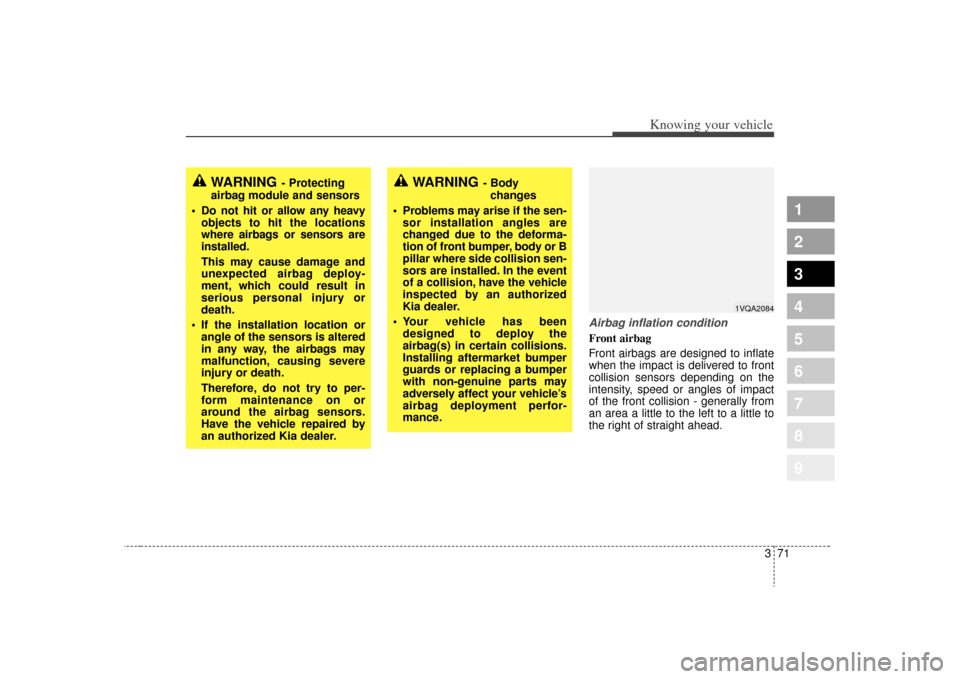
371
1
2
3
4
5
6
7
8
9
Knowing your vehicle
Airbag inflation conditionFront airbag
Front airbags are designed to inflate
when the impact is delivered to front
collision sensors depending on the
intensity, speed or angles of impact
of the front collision - generally from
an area a little to the left to a little to
the right of straight ahead.
WARNING
- Protecting
airbag module and sensors
Do not hit or allow any heavy objects to hit the locations
where airbags or sensors are
installed.
This may cause damage and
unexpected airbag deploy-
ment, which could result in
serious personal injury or
death.
If the installation location or angle of the sensors is altered
in any way, the airbags may
malfunction, causing severe
injury or death.
Therefore, do not try to per-
form maintenance on or
around the airbag sensors.
Have the vehicle repaired by
an authorized Kia dealer.
WARNING
- Body
changes
Problems may arise if the sen- sor installation angles are
changed due to the deforma-
tion of front bumper, body or B
pillar where side collision sen-
sors are installed. In the event
of a collision, have the vehicle
inspected by an authorized
Kia dealer.
Your vehicle has been designed to deploy the
airbag(s) in certain collisions.
Installing aftermarket bumper
guards or replacing a bumper
with non-genuine parts may
adversely affect your vehicle’s
airbag deployment perfor-
mance.
1VQA2084
Page 81 of 371
Knowing your vehicle72
3
1
2
3
4
5
6
7
8
9
Side airbag
Side airbags (side and curtain
airbags) are designed to inflate
depending on the strength, speed
and angles of impact of a side impact
collision or rollover. If the vehicle chassis is impacted by
bumps or objects on unimproved
roads or sidewalks, airbags may
deploy. Drive carefully on unim-
proved roads or on surfaces not
designed for vehicle traffic to prevent
unintended airbag deployment.
Airbag non-inflation conditions In certain low-speed collisions the
airbags may not deploy. The
airbags are designed not to deploy
in such cases because the risk of
injuries which can be caused by
the airbags exceeds the benefits
they provide in protecting occu-
pants.
OVQ036018N1KMB2064
1VQA2086
Page 104 of 371
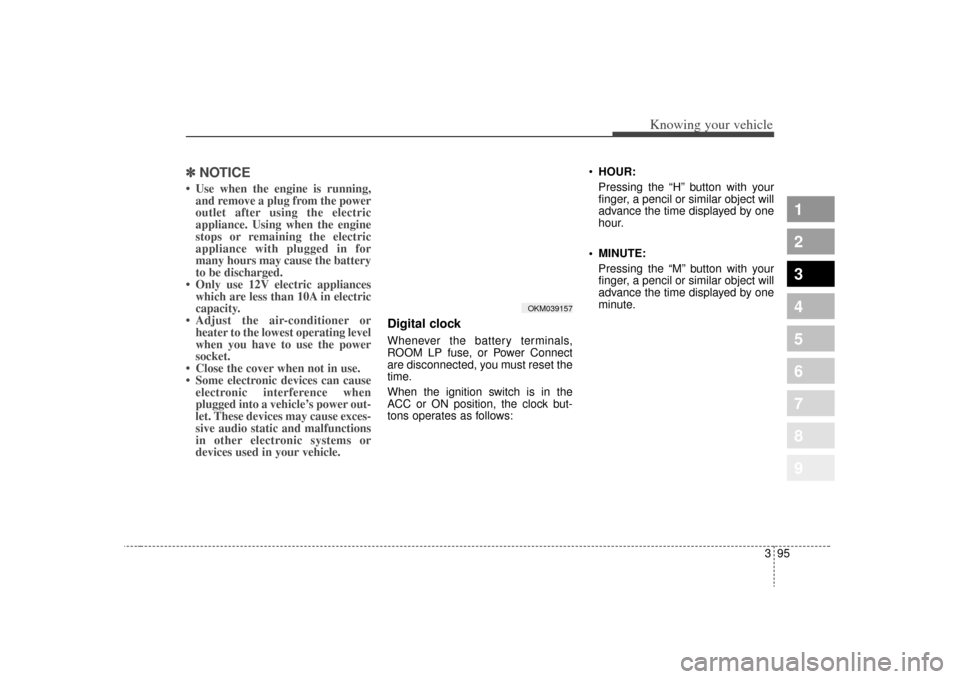
395
1
2
3
4
5
6
7
8
9
Knowing your vehicle
✽ ✽NOTICE• Use when the engine is running,
and remove a plug from the power
outlet after using the electric
appliance. Using when the engine
stops or remaining the electric
appliance with plugged in for
many hours may cause the battery
to be discharged.
• Only use 12V electric appliances which are less than 10A in electric
capacity.
• Adjust the air-conditioner or heater to the lowest operating level
when you have to use the power
socket.
• Close the cover when not in use.
• Some electronic devices can cause electronic interference when
plugged into a vehicle’s power out-
let. These devices may cause exces-
sive audio static and malfunctions
in other electronic systems or
devices used in your vehicle.
Digital clockWhenever the battery terminals,
ROOM LP fuse, or Power Connect
are disconnected, you must reset the
time.
When the ignition switch is in the
ACC or ON position, the clock but-
tons operates as follows:
HOUR:
Pressing the “H” button with your
finger, a pencil or similar object will
advance the time displayed by one
hour.
MINUTE: Pressing the “M” button with your
finger, a pencil or similar object will
advance the time displayed by one
minute.
OKM039157
Page 166 of 371
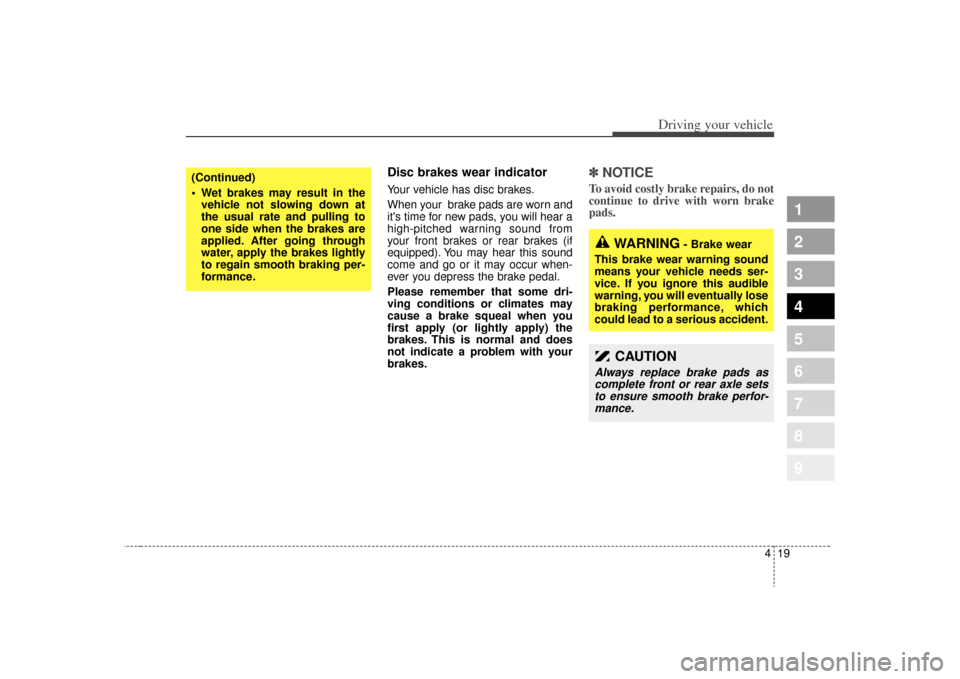
419
Driving your vehicle
1
2
3
4
5
6
7
8
9
Disc brakes wear indicator Your vehicle has disc brakes.
When your brake pads are worn and
it's time for new pads, you will hear a
high-pitched warning sound from
your front brakes or rear brakes (if
equipped). You may hear this sound
come and go or it may occur when-
ever you depress the brake pedal.
Please remember that some dri-
ving conditions or climates may
cause a brake squeal when you
first apply (or lightly apply) the
brakes. This is normal and does
not indicate a problem with your
brakes.
✽ ✽NOTICETo avoid costly brake repairs, do not
continue to drive with worn brake
pads.
WARNING
- Brake wear
This brake wear warning sound
means your vehicle needs ser-
vice. If you ignore this audible
warning, you will eventually lose
braking performance, which
could lead to a serious accident.
CAUTION
Always replace brake pads as complete front or rear axle setsto ensure smooth brake perfor-mance.
(Continued)
Wet brakes may result in the vehicle not slowing down at
the usual rate and pulling to
one side when the brakes are
applied. After going through
water, apply the brakes lightly
to regain smooth braking per-
formance.
Page 208 of 371
461
Driving your vehicle
1
2
3
4
5
6
7
8
9
1. Fan speed control knob
2. Mode selection knob
3. Temperature control knob
4. Air conditioning button (if equipped)
5. Air intake control button
6. Rear window defroster button (if equipped)
Fan speed control knob The ignition switch must be in the ON
position for fan operation.
The fan speed control knob allows
you to control the fan speed of the air
flowing from the ventilation system.
To change the fan speed, turn the
knob to the right for higher speed or
left for lower speed.
Setting the mode selection knob to
the “0” position turns off the fan.
Temperature control knobThe temperature control knob allows
you to control the temperature of the
air flowing from the ventilation sys-
tem. To change the air temperature in
the passenger compartment, turn
the knob to the right for warm and
hot air or left for cooler air.
MANUAL CLIMATE CONTROL SYSTEM (IF EQUIPPED)
OKM029130
OKM049136
OKM049134
Page 213 of 371
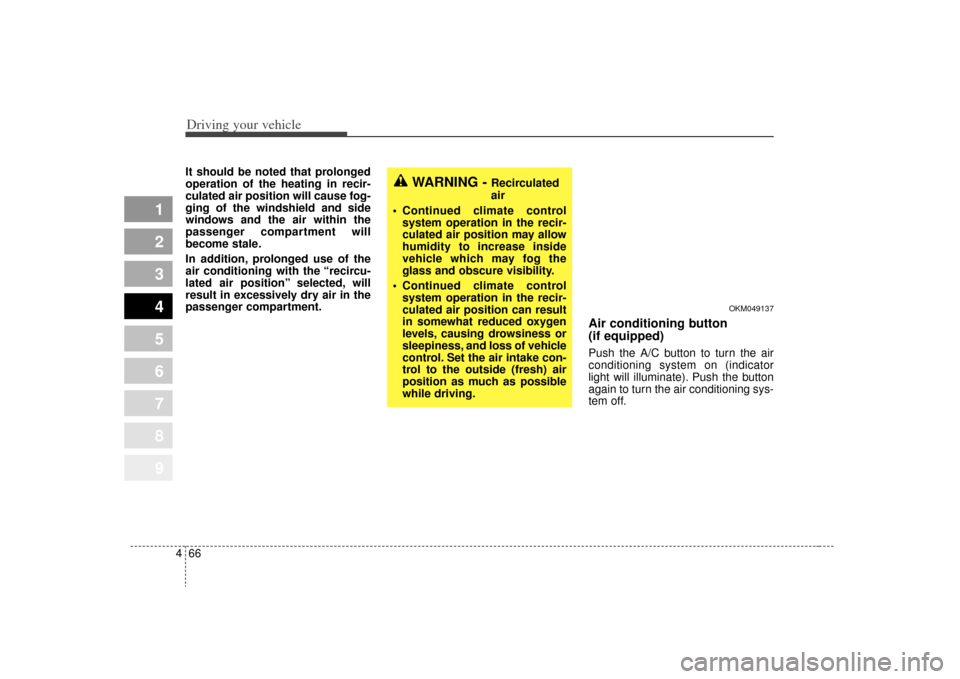
Driving your vehicle66
4
1
2
3
4
5
6
7
8
9
It should be noted that prolonged
operation of the heating in recir-
culated air position will cause fog-
ging of the windshield and side
windows and the air within the
passenger compartment will
become stale.
In addition, prolonged use of the
air conditioning with the “recircu-
lated air position” selected, will
result in excessively dry air in the
passenger compartment.
Air conditioning button
(if equipped) Push the A/C button to turn the air
conditioning system on (indicator
light will illuminate). Push the button
again to turn the air conditioning sys-
tem off.
WARNING -
Recirculated
air
Continued climate control system operation in the recir-
culated air position may allow
humidity to increase inside
vehicle which may fog the
glass and obscure visibility.
Continued climate control system operation in the recir-
culated air position can result
in somewhat reduced oxygen
levels, causing drowsiness or
sleepiness, and loss of vehicle
control. Set the air intake con-
trol to the outside (fresh) air
position as much as possible
while driving.
OKM049137
Page 214 of 371
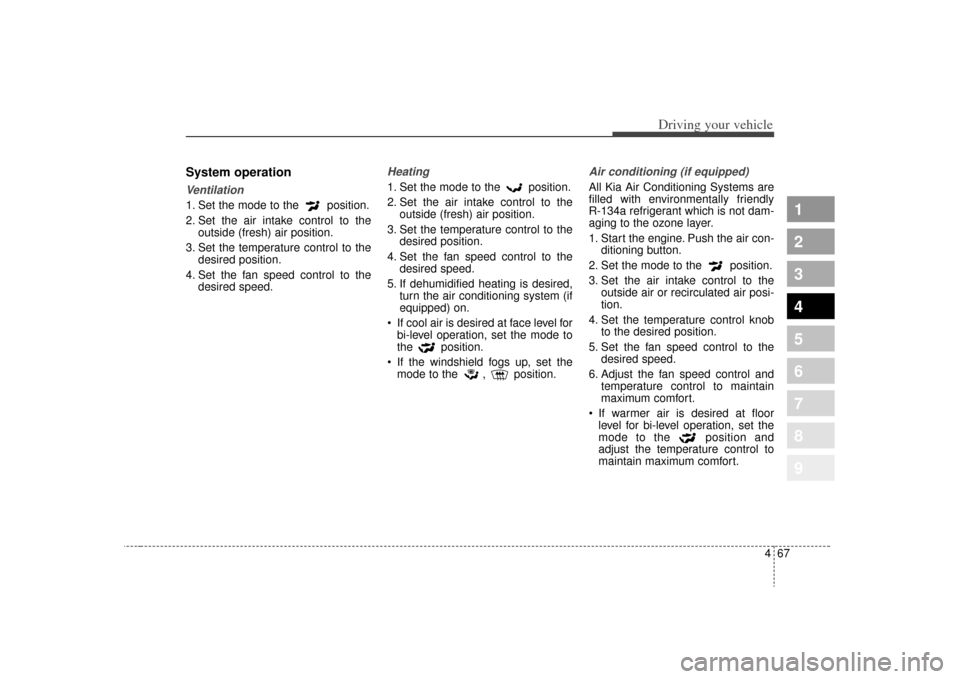
467
Driving your vehicle
1
2
3
4
5
6
7
8
9
System operationVentilation1. Set the mode to the position.
2. Set the air intake control to theoutside (fresh) air position.
3. Set the temperature control to the desired position.
4. Set the fan speed control to the desired speed.
Heating1. Set the mode to the position.
2. Set the air intake control to theoutside (fresh) air position.
3. Set the temperature control to the desired position.
4. Set the fan speed control to the desired speed.
5. If dehumidified heating is desired, turn the air conditioning system (if
equipped) on.
If cool air is desired at face level for bi-level operation, set the mode to
the position.
If the windshield fogs up, set the mode to the , position.
Air conditioning (if equipped) All Kia Air Conditioning Systems are
filled with environmentally friendly
R-134a refrigerant which is not dam-
aging to the ozone layer.
1. Start the engine. Push the air con- ditioning button.
2. Set the mode to the position.
3. Set the air intake control to the outside air or recirculated air posi-
tion.
4. Set the temperature control knob to the desired position.
5. Set the fan speed control to the desired speed.
6. Adjust the fan speed control and temperature control to maintain
maximum comfort.
If warmer air is desired at floor level for bi-level operation, set the
mode to the position and
adjust the temperature control to
maintain maximum comfort.
Page 215 of 371
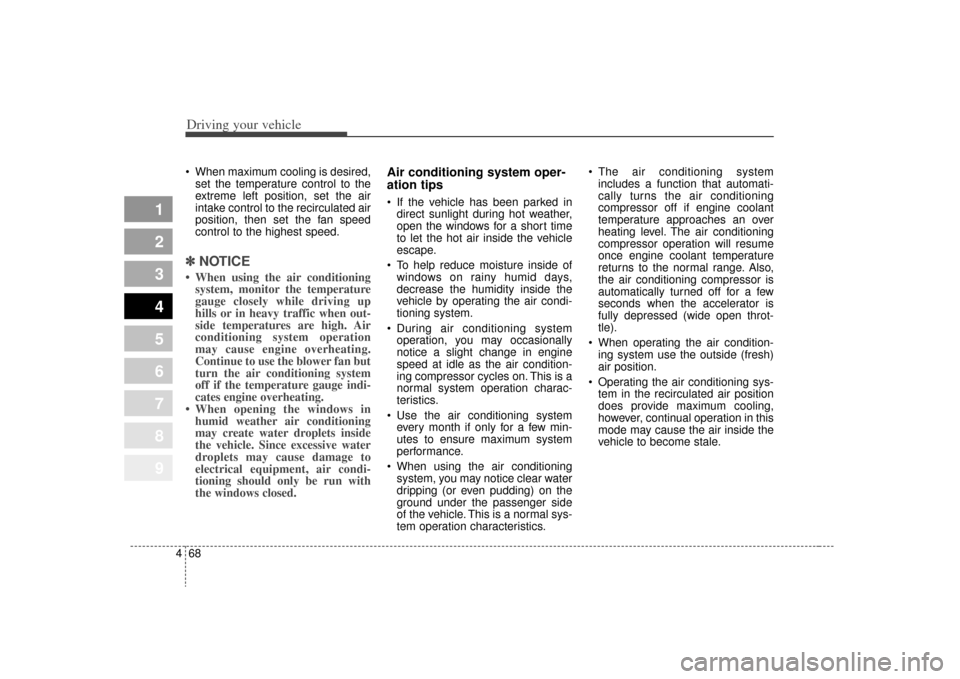
Driving your vehicle68
4
1
2
3
4
5
6
7
8
9
When maximum cooling is desired,
set the temperature control to the
extreme left position, set the air
intake control to the recirculated air
position, then set the fan speed
control to the highest speed.✽ ✽ NOTICE• When using the air conditioning
system, monitor the temperature
gauge closely while driving up
hills or in heavy traffic when out-
side temperatures are high. Air
conditioning system operation
may cause engine overheating.
Continue to use the blower fan but
turn the air conditioning system
off if the temperature gauge indi-
cates engine overheating.
• When opening the windows in humid weather air conditioning
may create water droplets inside
the vehicle. Since excessive water
droplets may cause damage to
electrical equipment, air condi-
tioning should only be run with
the windows closed.
Air conditioning system oper-
ation tips If the vehicle has been parked in
direct sunlight during hot weather,
open the windows for a short time
to let the hot air inside the vehicle
escape.
To help reduce moisture inside of windows on rainy humid days,
decrease the humidity inside the
vehicle by operating the air condi-
tioning system.
During air conditioning system operation, you may occasionally
notice a slight change in engine
speed at idle as the air condition-
ing compressor cycles on. This is a
normal system operation charac-
teristics.
Use the air conditioning system every month if only for a few min-
utes to ensure maximum system
performance.
When using the air conditioning system, you may notice clear water
dripping (or even pudding) on the
ground under the passenger side
of the vehicle. This is a normal sys-
tem operation characteristics. The air conditioning system
includes a function that automati-
cally turns the air conditioning
compressor off if engine coolant
temperature approaches an over
heating level. The air conditioning
compressor operation will resume
once engine coolant temperature
returns to the normal range. Also,
the air conditioning compressor is
automatically turned off for a few
seconds when the accelerator is
fully depressed (wide open throt-
tle).
When operating the air condition- ing system use the outside (fresh)
air position.
Operating the air conditioning sys- tem in the recirculated air position
does provide maximum cooling,
however, continual operation in this
mode may cause the air inside the
vehicle to become stale.